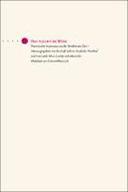Explore

Das flüchtige Werk
0 Ungluers have
Faved this Work
Login to Fave
The goal of this volume is to examine and describe the manifold improvisational culture around 1800. Therefore, different viewpoints are brought together, the focus lies, besides traditional source analysis, on methods and approaches of historical performance practice und historically informed music theory. What were the different esthetical viewpoints on pianistic improvisation? What were the standard models and conventional designs of improvised piano music of that time? How was improvisation taught? How can the conflict between generic approaches and the ideal of unmistakable individuality of the performer be described? Therefore, a variety of sources is examined by the contributors to this volume: italian partimenti, composed music that is guided by improvisational thinking (like Fantasia and Capriccio) textbooks, teaching documents, concert reports etc.. Besides the outstanding significance of Beethoven as improviser (already noted and admired by his contemporaries), this anthology tries to give a fuller picture by sheding light on then well-known figures like Ciacomo Tritto, Carl Czerny, Joseph Preindl, Joseph Lipavsky, Justin Heinrich Knecht and others.
This book is included in DOAB.
Why read this book? Have your say.
You must be logged in to comment.
Rights Information
Are you the author or publisher of this work? If so, you can claim it as yours by registering as an Unglue.it rights holder.Downloads
This work has been downloaded 94 times via unglue.it ebook links.
- 94 - pdf (CC BY-NC) at OAPEN Library.
Keywords
- Beethoven
- historical performance practice
- improvisation
- Music
- Music theory
- Musical analysis
- The arts
- thema EDItEUR::A The Arts::AV Music::AVA Theory of music and musicology
- Theory of music & musicology
Links
DOI: 10.26045/kp64-6176Editions

